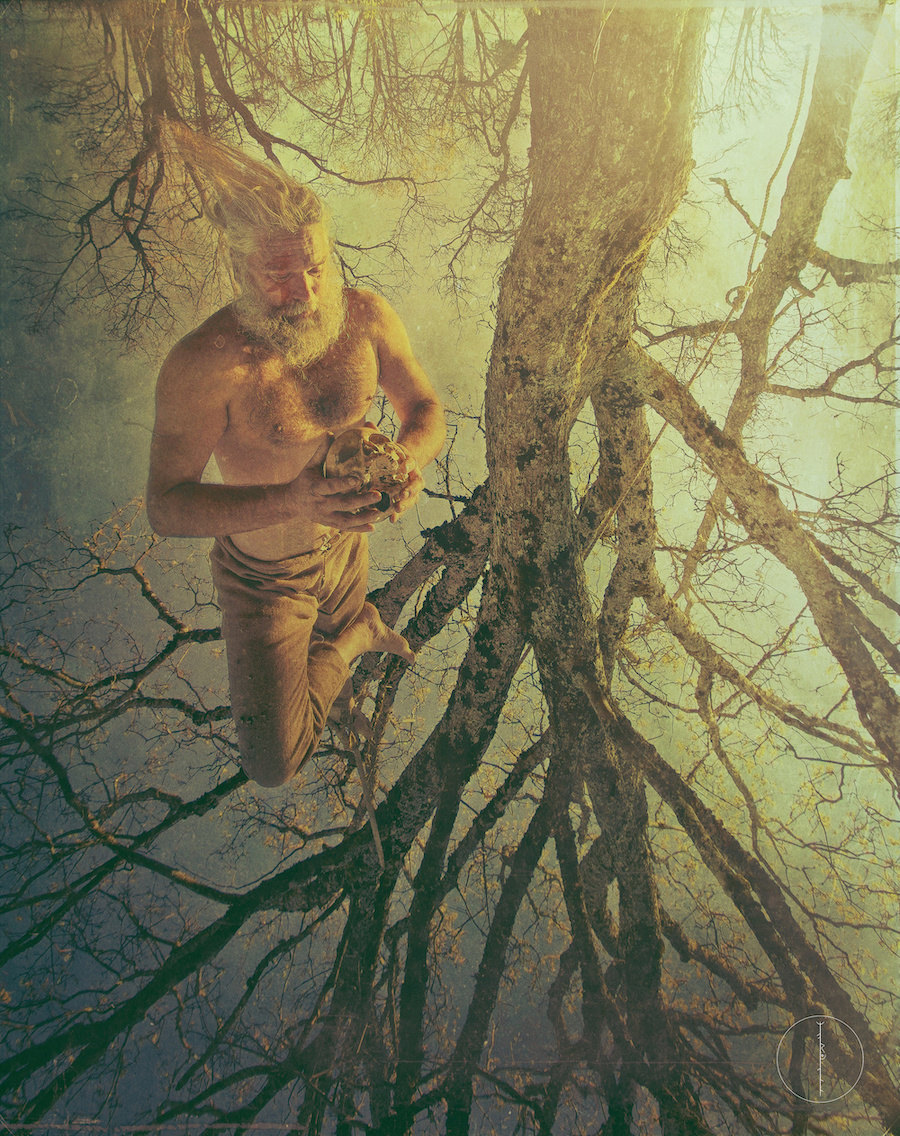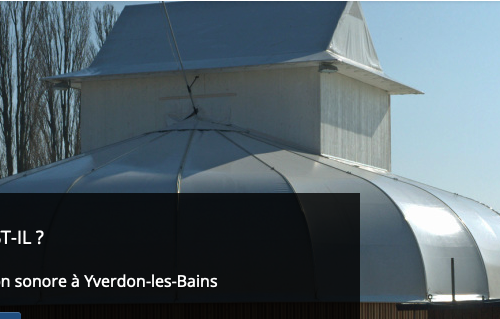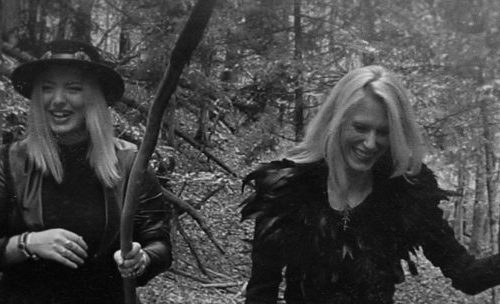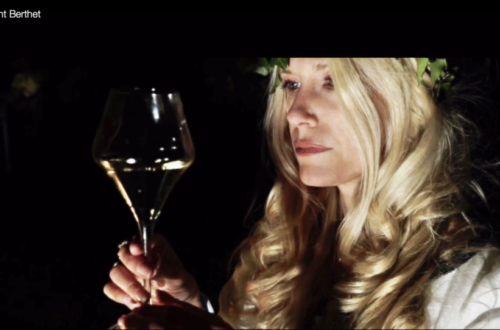
« Valþognir » chosen by David Morgan to illustrate a clever article about Odin
My photography « Valþognir » was chosen by David Morgan to illustrate a clever article about Odin and the metaphorical connexion with our physical body.
David, thanks for your support and work.
Thanks to Aasmundr to be a so implicated Odin figure in this picture.
*TRADUCTION FRANÇAISE PLUS BAS
In the Norse tradition, Odin is the All-Father God who hangs on the mighty tree Yggdrasil for 9 days. Odin does this in order to gain hidden knowledge. (the hanged man of the tarot holds a similar meaning).
Yggdrasil is the great central tree of Norse mythology around which all things exist. This world tree holds within its sphere the entire Cosmology of the Old Norse lore. (The Human body in anatomical allegory).
The All-Father is God of wisdom, he is God of healing, death, knowledge, victory, and magic. Odin is said to have hung on Yggdrasil to acquire knowledge of the ancient Norse symbol set – the Runes.
The name Odin is thought to derive from the pre-Germanic word Woadz or uoh-tos and this title is commonly linked to the idea of furry or frenzy.However, there are other takes on the name which fit the God of Wisdom and sacrifice just as well
Wodaz has connotations toward inspiration and prophecy and it has been shown to relate to the proto-Celtic term watis, meaning seer or prophet.(Wiki) – Vates is a Latin link :
« According to some scholars, the name Odin relates to the Latin term « vates » (prophet, seer) and is probably a Celtic loanword from the Gaulish language; linked with the old Welsh Guaut and Old Irish Fath, making uoh-tos or Wodaz to mean – « God inspired » in Germanic-Celtic ».This connection of Odin to the gift of divination and prophecy fits the one-eyed deity well –
In another great feat of endurance, Odin travels to the roots of the magical tree Yggdrasil to gain wisdom from the well of Mimir.
The well of Mimir is a spring of knowledge and inspiration; Odin is said to have sacrificed one of his eyes to enable him to drink from this deep source of ancient wisdom.
Heimdallr, the shining one and watchman of the gods, also drinks from this well with his magical horn Gjallarhorn – to sustain his strength and insight. (Heimdallr is likened to Prometheus by some; a God that brings learning and wisdom to Humanity).Odin may be also thought of in similar terms as Prometheus; a God of sacrifice – to enable the advancement and progress of Wisdom and knowledge.
Odin gives the sight of one eye to attain a greater vision. This may be looked upon as the metaphorical lessening of a physical and material outlook, in favour of deeper and long-lasting Spiritual insight.
In the anatomical allegory, the great tree is the human body and its trunk is the spinal column. Its branches are the nervous system, cardiovascular system, and endocrine system. The roots may be viewed as the sacral plexus nerve bundle located at the base of the Spine – or the cauda equina in Latin.
The Cauda equina (Sacral plexus) translates to the horse’s tail, and the great tree Yggdrasil (Human Body/Spine) is said to be Odin’s horse or steed. (a beautiful synchronicity).
Mimir’s Well is the pooled Creative energy at the chalice of the hips and the sacrifice of one eye is the conservation of this sacred energy of Generation.
In Norse tradition, Odin is known by many names, one of which is « The Wanderer » (Vegtam or Váfuðr in Old Norse) –
The largest cranial nerve of the body and the main component of the parasympathetic nervous system is called the Vagus nerve. (this nerve controls our rest and Regeneration).
The name Vagus comes from the Latin word Vega meaning « to wander » or « wandering ».
The Vagus nerve is called the wanderer because it wanders throughout all of our major glands and organs.
It is the Vagus nerve that links our body and brain, this nerve is the central conduit that stimulates our regeneration in times of quiet rest.
Perhaps the great Wanderer Odin, the wandering Vagus nerve of our parasympathetic nervous system, and the prophetic title Vates have familiar roots? (Insight and vision through rest and mindful movement).
https://www.facebook.com/photo/?fbid=1357693494676719…
In the anatomical allegory, the world tree is the Tree of Life, the tau tree cross of the hanged man, and the sacrificial cross of Christ.
The tree of Life is the human body, properly cared for.
Please see my other group posts for some continuity on ancient energy work and anatomical allegory.
Artwork – ᛘ ᚮ ᚱ ᚵ ᛆ ᚿ ᚿ MORGANN’ https://morganngyger.com Model: Aasmundr.
David Morgan https://www.facebook.com/photo?fbid=1569451876834212&set=gm.1327540991396007&idorvanity=281886105961506
Ma photographie « Valþognir » a été choisie par David Morgan pour illustrer un brillant article sur Odin et la connexion métaphorique avec notre corps physique.
David, merci pour votre soutien et votre travail.
Merci à Aasmundr d’être une figure d’Odin si impliquée dans cette image.
TRADUCTION DE L’ARTICLE DE DAVID MORGAN EN FRANCAIS:
« Dans la tradition nordique, Odin est « Le Dieu Père de tout ». Il s’est suspendu au puissant arbre Yggdrasil pendant 9 jours et 9 nuits, afin d’acquérir des connaissances cachées. (le pendu du tarot a une signification similaire).
Yggdrasil est le grand arbre central de la mythologie nordique autour duquel toutes choses existent. Cet arbre monde contient dans sa sphère toute la cosmologie de la tradition norroise. (Le corps humain dans l’allégorie anatomique).
Le Dieu père de tout est le Dieu de la sagesse, il est le Dieu de la guérison, de la mort, de la connaissance, de la victoire et de la magie. Il est dit qu’Odin s’est suspendu à Yggdrasil pour acquérir les connaissances de l’ensemble des symboles nordiques – les runes.
On pense que le nom Odin dérive du mot pré-germanique Woadz ou uoh-tos et ce titre est généralement lié à l’idée de fureur ou de frénésie.
Cependant, il existe d’autres versions du nom qui correspondent tout aussi bien au Dieu de la Sagesse et du sacrifice –
Wodaz a des connotations d’inspiration et de prophétie et il a été démontré qu’il est lié au terme proto-celtique watis, qui signifie voyant ou prophète.
(Wiki) – Vates: origine latine :
« Selon certains érudits, le nom Odin se rapporte au terme latin « vates » (prophète, voyant) et est probablement un emprunt celtique de la langue gauloise; lié à l’ancien gallois Guaut et au vieil irlandais Fath, faisant uoh-tos ou Wodaz signifier – « Dieu inspiré » en germanique-celtique ».
Cette connexion d’Odin au don de divination et de prophétie correspond bien à la divinité borgne –
Dans un autre grand exploit d’endurance, Odin se rend aux racines de l’arbre magique Yggdrasil pour acquérir la sagesse du puit de Mimir. (ou source de Mimir)
Le puit de Mimir est une source de connaissance et d’inspiration. On dit qu’Odin a sacrifié un de ses yeux pour lui permettre de boire à cette source profonde de sagesse ancienne.
Heimdallr, le brillant et gardien des Dieux, boit également de ce puit avec sa corne magique Gjallarhorn – pour maintenir sa force et sa perspicacité. (Heimdallr est comparé à Prométhée par certains ; un Dieu qui apporte l’apprentissage et la sagesse à l’humanité).
Odin peut également être considéré dans des termes similaires à Prométhée; un Dieu de sacrifice – pour permettre l’avancement et le progrès de la Sagesse et de la connaissance.
Odin sacrifie la vision de l’un de ses yeux pour atteindre une plus grande vision. Cela peut être considéré comme la diminution métaphorique d’une perspective physique et matérielle, au profit d’une vision spirituelle plus profonde et durable.
Dans l’allégorie anatomique, le grand arbre représente le corps humain et son tronc, la colonne vertébrale. Ses branches sont le système nerveux, le système cardiovasculaire et le système endocrinien. Les racines peuvent être considérées comme le faisceau nerveux du plexus sacré situé à la base de la colonne vertébrale – ou la queue de cheval en latin.
La Cauda equina (plexus sacré) se traduit par la queue du cheval, et le grand arbre Yggdrasil (corps humain/colonne vertébrale) serait le cheval ou le coursier d’Odin appelé Sleipnir. (une belle synchronicité).
La source de Mimir est l’énergie Créatrice associée au calice des hanches et le sacrifice de l’œil est la conservation de cette énergie sacrée de la Génération.
Dans la tradition nordique, Odin est connu sous de nombreux noms, dont l’un est « The Wanderer »: le vagabond (Vegtam ou Váfuðr en vieux norrois) –
Le plus grand nerf crânien du corps et le composant principal du système nerveux parasympathique est appelé le nerf vague ou vagal. (ce nerf contrôle notre repos et notre régénération).
Le nom Vagus vient du mot latin Vega signifiant « errer » ou « errer ».
Le nerf vague est appelé le vagabond car il se promène dans toutes nos glandes et organes principaux.
C’est le nerf vague qui relie notre corps et notre cerveau, ce nerf est le conduit central qui stimule notre régénération en période de repos au calme.
Peut-être que le grand Vagabond Odin, le nerf vague errant de notre système nerveux parasympathique, et le titre prophétique Vates ont des racines familières ? (Perspicacité et vision par le repos et le mouvement conscient).
https://www.facebook.com/photo/?fbid=1357693494676719&set=a.975791192866953
Dans l’allégorie anatomique, l’arbre du monde est l’arbre de vie, la croix de l’arbre, le tau du pendu et la croix sacrificielle du Christ.
L’arbre de Vie est le corps humain, bien entretenu.
Veuillez consulter mes autres messages de groupe pour une certaine continuité sur le travail énergétique ancien et l’allégorie anatomique. »
Texte par David Morgan (traduction française par Morgann Bjørkekråka)
Oeuvre – ᛘ ᚮ ᚱ ᚵ ᛆ ᚿ ᚿ MORGANN’ [https://morganngyger.com]
Modèle : Aasmundr.
Model: Aasmundr.





